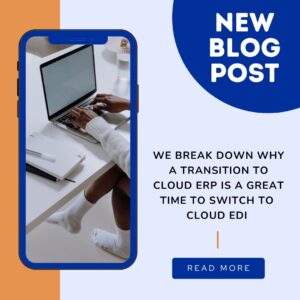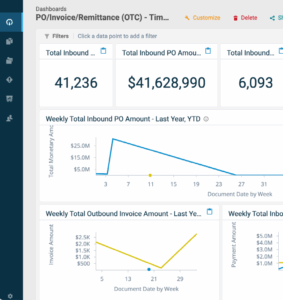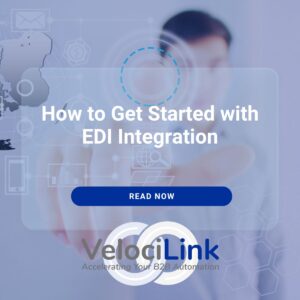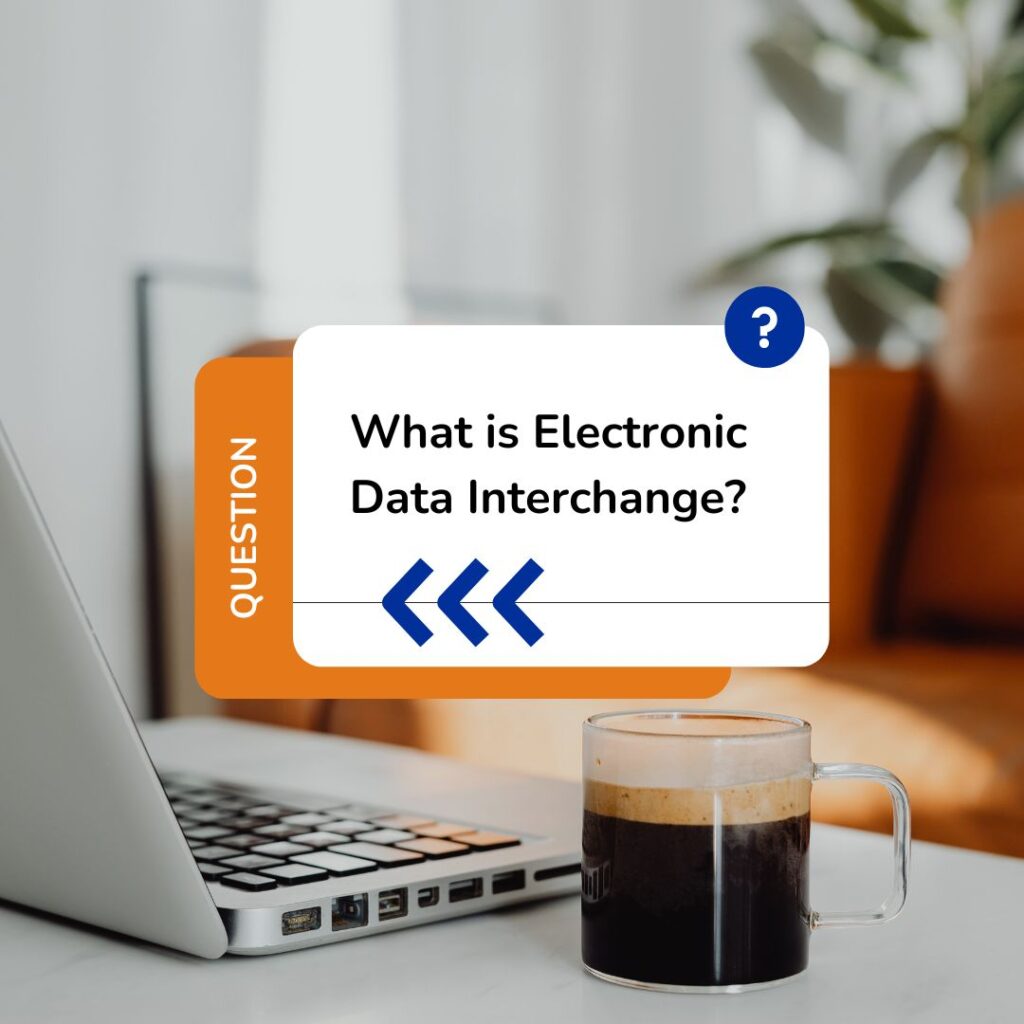
Updated 7/18/25
As businesses increasingly embrace digital transformation, the shift to cloud-based solutions is becoming a strategic necessity. Many organizations are now transitioning to Cloud Enterprise Resource Planning (ERP) systems like CloudSuite and Acumatica to enhance efficiency, scalability, and collaboration. However, one critical aspect often overlooked in this migration is the integration of Electronic Data Interchange (EDI) solutions. This blog explores why switching to a Cloud EDI software solution like GraceBlood’s VelociLink™ is essential when moving to a Cloud ERP environment.
Table of Contents
- Understanding the Foundation: EDI and Cloud ERP
- Why Cloud EDI Compliments Cloud ERP
- Strengthening Operations with Cloud EDI
- Meeting Industry Demands Standards
- Unlocking Deeper Business Insights
- Staying Agile in an Evolving Business Landscape
Understanding the Foundation: EDI and Cloud ERP
Before diving into the benefits, let’s clarify what EDI and cloud ERP are.
What is EDI?
EDI is the electronic exchange of business documents in a standardized format between organizations, facilitating efficient transactions and communication. EDI capability is required in many industries, particularly food and beverage, CPG and manufacturing. Depending on the industry and your unique business needs, EDI requirements can vary widely, ranging from which standard you need to adhere to (ANSI X12 or EDIFACT), EDI communication method (AS2 or VAN), and even file format and integration needs like API.
What is Cloud ERP?
Cloud ERP is an integrated suite of applications hosted in the cloud that manages various business processes, including finance, supply chain, and human resources. It supports scalability, flexibility, and real-time data access—crucial for today’s competitive supply chain. Which ERP solution you choose will directly affect your EDI capabilities so be sure to ask these necessary questions during the selection process:
- What file formats are supported?
- What is the integration method (API, flat file, web services, etc.)?
- Is real-time data exchange supported or only batch processing?
- Can the ERP accommodate custom or industry-specific EDI standards?
Why Cloud EDI Compliments Cloud ERP
Seamless Integration for End-to-End Visibility
When switching to Cloud ERP, it’s vital to ensure that all your business processes work harmoniously. Cloud EDI is an end-to-end EDI solution designed to integrate smoothly with Cloud ERP systems, enabling real-time document exchange. And the best providers of these solution offer streamlined implementation and support services to ensure businesses maximize the value of their technology investments. This integration eliminates manual data entry, reduces errors, and speeds up transaction processes. With seamless integration, businesses can improve operational efficiency and enhance decision-making through timely access to data. This kind of innovation leads to truly data-driven strategies that foster growth.
Cost Effectiveness & Predictable Spending
Switching to Cloud EDI can lead to significant cost savings. Traditional EDI solutions often require substantial upfront investments in hardware and EDI software, along with ongoing maintenance costs. Not to mention sometimes overlooked costs for full-time employees to onboard new trading partners, execute map development and manage exception handling. Cloud EDI, however, operates on a subscription model, allowing businesses to pay only for what they use. This model can reduce overhead costs and provide a more predictable budgeting framework. Additionally, the savings generated by reduced paper usage, postage, and labor costs further enhance the financial benefits.
Scalability & Flexibility
One of the key advantages of cloud-based solutions is their scalability. As your business grows, your EDI integration needs may also evolve. Cloud EDI solutions offer the flexibility to easily scale up or down based on your business requirements. Whether you’re expanding into new markets or adjusting to seasonal fluctuations, a cloud-based EDI system can accommodate changes without the need for extensive reconfiguration.
Strengthening Operations with Cloud EDI
Enhancing Data Accuracy & Security
Data accuracy is crucial for maintaining healthy business relationships and ensuring compliance with industry standards. Cloud EDI significantly reduces the risk of human error associated with manual data entry, leading to more accurate data exchange. Furthermore, cloud providers typically invest heavily in cybersecurity measures like multiple data centers and end-to-end encryption to protect sensitive data. Enhanced security protocols, such as multi-factor authentication, ensure that your EDI transactions remain safe during transmission and at rest.
Boosting Collaboration with Trading Partners
In our highly interconnected and global business landscape, collaboration is key. Cloud EDI solutions foster better collaboration with trading partners by enabling real-time communication and data sharing. This improved connectivity allows for quicker response times, better inventory management, and streamlined order fulfillment. When combined with Cloud ERP, the result is a more agile supply chain that can adapt to market changes swiftly and are better equipped to ride out disruptions.
Meeting Industry Demands & Standards
Built-In Compliance Capabilities
In many industries, compliance with various regulations and standards is a necessity. Cloud EDI systems often come pre-configured to meet industry-specific standards, making it easier for businesses to maintain compliance. This feature is particularly beneficial when integrating with a Cloud ERP system, as it ensures that all business processes adhere to required regulations without additional manual oversight.
Supporting Change Management
Additionally, effective change management is essential during any transition to new systems. Cloud EDI facilitates change management by providing automated compliance updates and alerts when regulations evolve. This proactive approach minimizes the risk of non-compliance, allowing businesses to adapt swiftly to EDI formats without extensive manual oversight. Many Cloud EDI providers adhere to the System and Organization Controls (SOC) standards, which provide a framework for managing data securely. SOC compliance ensures that your EDI processes are trustworthy and that sensitive data is protected.
Unlocking Deeper Business Insights
Enhanced Analytics & Reporting
One of the most significant benefits of Cloud EDI in conjunction with Cloud ERP is the ability to leverage data analytics like VelociLink™ EDI Analytics . Cloud ERP systems often include robust reporting and analytics tools that, when integrated with Cloud EDI, provide deeper insights into business performance. This synergy allows companies to analyze transaction trends, inventory levels, and customer behavior, driving informed decision-making and strategic planning.
Faster Onboarding of Trading Partners
The traditional EDI setup can be time-consuming and cumbersome, particularly when onboarding new trading partners, leading to a backlog and potentially losing business. Cloud EDI simplifies this process through standardized protocols like GraceBlood’s GADGET methodology and onboarding templates , allowing businesses to connect with new partners more quickly. The streamlined onboarding process not only saves time but also enhances collaboration and strengthens relationships with suppliers and customers.
Staying Agile in an Evolving Business Landscape
Mobility & Accessibility
With a constantly moving target, accessibility is paramount. Cloud EDI integration solutions offer the advantage of mobility, allowing users to access EDI data and documents from anywhere, at any time. This accessibility is particularly beneficial for remote teams and those working in the field. When integrated with Cloud ERP, it enables employees to stay informed and responsive, regardless of their location.
Future Proofing Your Business
Finally, adopting Cloud EDI alongside Cloud ERP positions your business for future growth. As technology continues to evolve, businesses must stay agile to remain competitive. Cloud solutions are inherently more adaptable to technological advancements, enabling easier integration with emerging technologies such as artificial intelligence (AI) and machine learning (ML). This future-proofing ensures that your business can continue to innovate and thrive in an ever-changing landscape.
It’s Official: Cloud ERP Plays Well with Cloud EDI
Transitioning to a Cloud ERP system is a significant step in your organization’s digital transformation journey. However, to maximize the benefits of this transition, it is equally important to adopt a Cloud EDI solution. The seamless integration, cost-effectiveness, scalability, data accuracy, and enhanced collaboration provided by Cloud EDI can transform your business operations, driving efficiency and enabling growth. As you make the switch to Cloud ERP, don’t overlook the critical role that Cloud EDI will play in your success. Embrace the change and unlock the full potential of your business. If you’re thinking about migrating to a cloud ERP solution, we invite you to schedule a consultation with one of our consultants to explore a simultaneous transition to Cloud EDI. Let’s ensure you maximize the benefits of both systems together!










